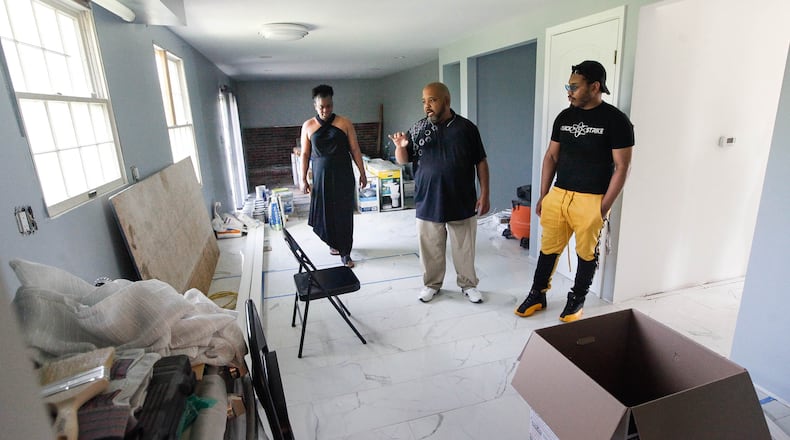“All I did was pray. My daughter cried. We all held hands ... It was just very, very terrifying,” Derrick Stephens said.
The walls of their house shifted and more than 60% of their roof was gone, revealing the sky above.
The Stephens were insured and thought the process of rebuilding would go without a hitch. An adjuster came out right away. They filed claims, found a place to rent and thought they’d be back home in six to eight months.
The Stephens were mistaken. So were others, some in dragged out disputes with their insurance or builders.
An assessment made in March shows that the region might be down to about 30 single family homes where little progress on tornado repairs has been made, according to the Miami Valley Long-Term Recovery Operations Group, which organizes repair and rebuilding projects entered through the region’s case management system.
Twenty-three are in Dayton, with others in Clayton, Harrison Twp., Trotwood and Vandalia. The group is sending out letters to owners of 15 who might be eligible for assistance.
But the window is closing for tornado-impacted homeowners who lacked insurance or were underinsured to get help. The Miami Valley Long-Term Recovery Operations Group will dissolve in October, said Laura Mercer the group’s executive director.
Local housing agencies working on rebuilding can also utilize Federal Home Loan Bank grants — but not for long. The $20,000 grants to repair, rebuild or replace homes will end June 18, the second anniversary of the federal disaster declaration.
Homeowners who still need rebuilding help must act fast to receive an FHLB grant, said Amy Radachi, president and CEO of Rebuilding Together Dayton, a group that recently assessed 35 homes with needed tornado repairs.
“There are still people with roof leaks and siding repairs and broken windows and all sorts of damage still from two years ago,” she said. “We are still working on reaching out to as many folks as possible. There is still help available.”
‘I’ve cried my eyes out’
A record 16 tornadoes slashed across the region that night with the storms spawning five more in other areas of the state.
An auditor’s analysis showed 4,434 properties were affected to some degree, with 913 destroyed or with major damage in Montgomery County. In Greene County, 86 properties were destroyed and 206 had major damage, according to the county auditor. Ten homes were destroyed in Miami County and another 44 properties were impacted, according to the county.
The largest of the Memorial Day tornadoes was the EF4 that spun up in Perry Twp. and moved east into Brookville before hitting Trotwood.
A majority of the 228 homes damaged in Brookville were clustered in Terrace Park, where nearly 70% of the 192 homes were affected; one in three destroyed or severely damaged.
While the tree canopy isn’t the same, Terrace Park is nearly back to normal, said Ray Vickers, who has lived there with his wife, Sheryl, for more than 20 years.
“Everything’s rebuilt. It’s beautiful back here,” he said. “There are about three empty lots, and there are a couple homes yet that are still needing repair but they’re not leveled.”
Vickers said he, along with most of his neighbors, had little trouble with insurance, and most repairs and rebuilding was completed within a year. New houses would likely be filling the empty lots now if lumber prices weren’t so high, he said.
Pete Scambilis of Beavercreek said he had no problems with his insurance or builder, moving back to Rosehill Drive about six months ago.
After the tornadoes, the family climbed out of the basement and over debris. The roof had been ripped off. The house was a total loss, and trees crushed four of the six cars in the driveway.
“We think about it every day,” Scambilis said.
Scambilis said he was on the phone with his insurance agent within minutes of the storm. Scambilis and his family stayed in a hotel for a few months, then moved into his parents’ vacant home because they’re in a retirement community.
Behind the Scambilis house, Nancy and Tom Stewart are still working to put their home back together.
As they cowered in the basement, the Stewarts could hear their cedar home splintering. Water from pipes and insulation fell on them. Nearly every wall fell in.
“I’ve cried my eyes out over this,” Nancy Stewart said. “I loved my old house.”
The Stewarts got back into their home in October, but they say it is not finished and their builder, Michaels-Colston Custom Homes, owes them money. Builder Lloyd Colston denied that, saying he asked subcontractors to discount items because they were rebuilding a home for someone who went through the tornadoes.
Neighbors on either side of them on Rushton Drive leveled their homes and sold their lots. They still sit empty.
The neighborhood used to have tall, old trees separating neighbors. Nancy Stewart said her backyard used to be her paradise and a secluded space. After the tornadoes,few trees remained.
“I don’t feel like we’re home yet,” Tom Stewart said. “We haven’t got closure.”
‘The way they treated us is the true disaster’
Jenny Andrea and Sarah Nussman have been fighting to get insurance money to repair their Wendover Drive home in Beavercreek. But it sits basically as it was immediately after an EF3 tornado came through the neighborhood. They have re-tarped a hole in the roof four times.
“We’ve been on our own from day one and they’ve pushed back on basically every area of the policy,” Andrea said. “You have insurance so that they got your back when something like this happens.”
Their insurance, Van Wert-based Central Mutual, gave them $80,000 for damages, which Andrea said came far short of the more than $200,000 estimates from contractors that all recommended rebuilding the house.
Central Mutual dropped their coverage in November with an open claim. Andrea and Nussman sued in January.
The insurer declined to comment. In its response to Andrea’s suit, it denies most of the allegations and filed a countersuit, saying that she hasn’t taken proper action to safeguard the house from further damage; that the insurance company gave her money for a pet fee at her rental home, but that money was not spent on a pet fee; and that they gave her money for renting furniture but she didn’t rent furniture.
Andrea said the money they were sent for those things was in a lump sum.
“The way they treated us is the true disaster,” Andrea said. “I wouldn’t wish this on anyone.”
Daunting task
For some, getting the work done has been “messy,” Mercer said.
“During COVID — the whole time period, so many contractors were fully booked, so I think it was difficult to find qualified contractors,” she said.
Whole-house repair is a daunting task, Mercer said.
“Most people are pretty inexperienced in figuring out how to work with contractors to get this level of work done,” she said. “They might have hired a plumber or an electrician before for their house, but major construction is not in the realm of what the average homeowner has to do in their lifetime. When you have a catastrophic event, and you’re dealing with roofing, and structural issues, and flooring, and plumbing and electrical, that’s a lot for somebody who hasn’t had that kind of experience.”
Curse and a blessing
The recovery group is now helping the Stephens family finish work on their Trotwood home.
“I didn’t think we would need them, because everything had gone so smoothly up until the last denials from the insurance company,” Kandace Stephens said. “I had no way of anticipating that we would still be this far from finished when we had to part company with our contractor.”
Since the tornado, the Stephens have moved six times, spending at least nine months of it with as many as six family members crammed together in a hotel room. A battle with COVID-19 put Derrick Stephens in the hospital and on a respirator fighting for his life in November.
Derrick Stephens wouldn’t disclose which insurance company the family is having problems with, but he has retained an attorney to try to resolve the impasse. An alleged no-show contractor also is the subject of numerous consumer complaints and has been sued before by the Ohio Attorney General.
Derrick said they received about $100,000 from the insurance company but the costs — even if the contractor had stayed on the job — were going to run more than $150,000 he said.
More work has been accomplished on the house in past three weeks by Brethren Disaster Ministries volunteers and the recovery group’s paid contractors than during the entire time since the tornado, Kandace Stephens said.
The past two years have been a curse and a blessing, she said. The family has been touched by the staff at hotels who helped them quarantine through the pandemic, workers at lumber yards, and now the volunteers helping them complete work on the the house.
“We all got to see how wonderful people really, truly can be in times of great distress. No one had to do any of what they did for us. And yet they did it anyway,” she said. “That was a wonderful balance to have all these people saying, ‘Hey, how can we help?’ in a time when we needed it most.”
The family expects to return home in July and join their neighbors once again for a summer block party — a much-anticipated annual event before the tornadoes.
“I’ll just be happy when they say we’re done,” Derrick said. “I can come home and walk around and be satisfied and lay in my own bed without having to worry about paying for a hotel stay or paying for an apartment.”
The couple said tornado survivors who still need help shouldn’t quit, give up hope or feel embarrassed about reaching out for help — even two years later.
“We’ve talked to people at Home Depot and Lowe’s and grocery stores that are still going through this and still being affected,” Derrick said. “It’s just a lot. I never would think that we’re the only ones left — not in a million years.”
Where to still get help, donate
Residents affected by the 2019 Memorial Day tornadoes can still get help with repairs and to replace trees lost in the storm. Financial donations can also be made to support the initiatives.
Assistance for homeowners
Miami Valley Long-Term Recovery Operations Group
Homeowners needing assistance should contact the Miami Valley Long-Term Recovery Group’s case management team soon as one federal funding source will expire in June and the group will end its work in October. For help call 937-223-7217 ext. 1137.
Rebuilding Together Dayton
Rebuilding Together Dayton is still offering assistance to homeowners who need help with tornado repairs. For help call 937-223-4893 visit online at https://rtdayton.org/disasterrecovery or email disasterrecovery@rtdayton.org.
Tornado Survivors’ Pathways to Homeownership Program
How to apply: Tornado-impacted non-homeowners who would like to become mortgage-ready to own a home can apply for the program at www.homeownershipdayton.org.
How to donate: You can contribute to the Tornado Survivors’ Pathways to Homeownership Fund (Fund #8561) at The Dayton Foundation, online at: https://www.daytonfoundation.org/ccgift.html?ReturnFundID=8561&ReturnFundName=Tornado Survivors Pathway to Homeownership%20&Source=EXT. You mail also mail a check with the fund name and number referenced on the memo line or attached letter to: The Dayton Foundation, 1401 S. Main St., Suite 100, Dayton, Ohio 45409.
RETREET Program
How to apply: The program will help replace 1,000 trees in tornado-damaged areas. Impacted homeowners interested in having free, native trees planted at their homes can apply at www.retreet.org/mvtc.
How to donate: You can contribute financially to the Miami Valley TREEcovery Campaign (Fund #8647) at The Dayton Foundation, online at: https://www.daytonfoundation.org/ccgift.html?ReturnFundID=8647&ReturnFundName=Miami_Valley_TREEcovery_Campaign%20&Source=EXT or mail a check with the fund name and number referenced on the memo line or attached letter to: The Dayton Foundation, 1401 S. Main St., Suite 100, Dayton, Ohio 45409.


